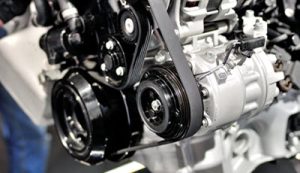When it comes to engine performance, air is just as crucial as fuel. Without the right amount of oxygen, combustion becomes incomplete, resulting in poor power delivery, high emissions, and increased fuel consumption. Engine air compressors are designed to solve this issue by delivering compressed air to ensure optimal combustion. Whether used in heavy-duty trucks, industrial machinery, or modern turbocharged engines, air compressors play a vital role in maximizing efficiency, reliability, and performance.
Understanding the Basics of Engine Air Compressors

An engine air compressor is a mechanical device that increases the pressure of air by reducing its volume. The compressed air is then used for various purposes depending on the vehicle type. In trucks and heavy equipment, it powers air brakes and suspension systems. In internal combustion engines, especially turbocharged or supercharged ones, compressed air enhances fuel combustion by supplying more oxygen to the cylinders.
Primary Functions of Engine Air Compressors:
-
Boosting air intake pressure for efficient combustion
-
Powering pneumatic systems (brakes, suspension, valves)
-
Assisting engine cooling and ventilation systems
-
Maintaining air reservoir pressure for consistent operation
How Engine Air Compressors Operate
The basic working principle of an air compressor involves intake, compression, and delivery. Here’s a simplified breakdown of the process:
-
Air Intake: Ambient air enters through an air filter to remove dust and impurities.
-
Compression: The piston or rotary element compresses the air, raising its pressure and temperature.
-
Cooling: The compressed air often passes through an intercooler or aftercooler to reduce heat.
-
Delivery: The high-pressure air is stored in a tank or directly supplied to the engine or pneumatic system.
Types of Engine Air Compressors
Different engines use different compressor designs depending on application and performance needs.
| Type | Description | Common Applications |
|---|---|---|
| Reciprocating (Piston) Compressor | Uses pistons and cylinders to compress air | Heavy trucks, buses, diesel engines |
| Rotary Screw Compressor | Uses rotating helical screws for continuous air compression | Industrial engines, heavy-duty vehicles |
| Turbo Compressors (Turbochargers) | Driven by exhaust gases to compress intake air | Passenger cars, performance vehicles |
| Roots-Type Blower (Supercharger) | Mechanically driven by a belt for instant boost | Racing and performance engines |
Each type has its advantages. Reciprocating compressors are durable and easy to service, while turbo compressors offer superior efficiency by utilizing waste exhaust energy.
Key Components of an Engine Air Compressor
To maintain reliable performance, each component must function precisely.
-
Crankshaft and Piston Assembly: Convert mechanical energy into compression force.
-
Cylinder Head: Contains intake and exhaust valves that regulate airflow.
-
Cooling System: Prevents overheating during compression.
-
Lubrication System: Reduces friction and ensures longevity.
-
Pressure Relief Valve: Protects the system from excessive pressure buildup.
-
Air Dryer: Removes moisture to prevent corrosion in pneumatic systems.
The Role of Air Compressors in Combustion Efficiency
Efficient combustion requires a perfect air-to-fuel ratio. When the engine receives compressed air, it improves the mixing of air and fuel, leading to cleaner and more powerful explosions within the cylinders.
Benefits of Proper Air Compression:
-
Improved fuel economy: More efficient combustion reduces fuel waste.
-
Higher power output: Denser air allows more fuel to burn effectively.
-
Lower emissions: Complete combustion minimizes CO and HC emissions.
-
Stable engine performance: Consistent air pressure ensures smoother operation.
| Parameter | Without Compressor | With Compressor |
|---|---|---|
| Air density | Low | High |
| Combustion efficiency | Moderate | Optimal |
| Power output | Standard | Enhanced |
| Emissions | Higher | Lower |
Maintenance Tips for Engine Air Compressors
To ensure your air compressor performs at its best, regular inspection and maintenance are essential.
Recommended Maintenance Checklist:
-
Check air filters regularly to prevent dirt buildup.
-
Inspect belts and pulleys for wear and proper tension.
-
Drain moisture from air tanks or dryers daily in humid environments.
-
Monitor oil levels and change compressor oil according to manufacturer guidelines.
-
Inspect pressure relief valves and safety systems periodically.
Common Warning Signs of Compressor Issues:
-
Reduced air pressure or slow system response
-
Unusual noise or vibration
-
Oil leaks near fittings or valves
-
Overheating during operation
-
Air leakage from hoses or fittings
Addressing these signs early prevents costly breakdowns and ensures optimal engine performance.
Safety Considerations
Because air compressors operate under high pressure, safety precautions are critical:
-
Never exceed manufacturer-recommended pressure limits.
-
Avoid working on a pressurized system — always release pressure first.
-
Use correct lubricants to prevent overheating or damage.
-
Regularly inspect for cracks, leaks, or corrosion.
Proper handling and regular maintenance extend compressor lifespan and maintain reliable engine operation.
Where to Buy Quality Engine Air Compressors

Choosing the right compressor ensures your engine performs efficiently and reliably under all conditions. For top-quality products that meet OEM standards, visit Buy compressor online Here you can find durable, high-performance compressors and components for a wide range of vehicles.
Final Thoughts
The engine air compressor is more than just a support component — it’s a key player in achieving optimal combustion efficiency. By providing the necessary air pressure and maintaining consistent delivery, it helps engines run smoother, burn fuel cleaner, and perform better. Regular maintenance and timely replacement of worn components can make the difference between a struggling engine and one that performs at peak efficiency.
If you want your vehicle’s engine to breathe — and perform — at its best, start by keeping your air compressor in perfect shape.